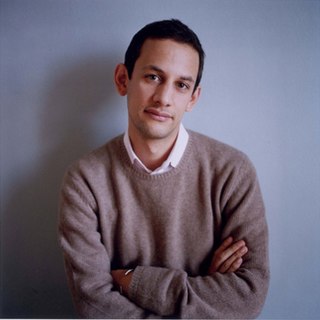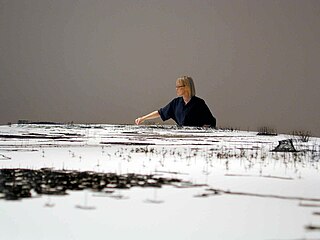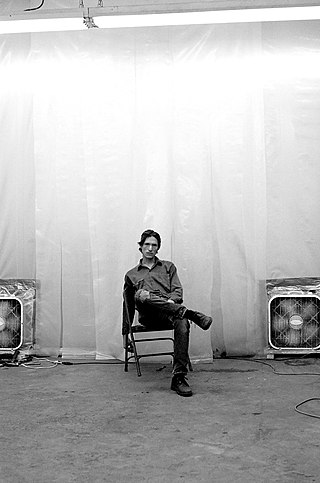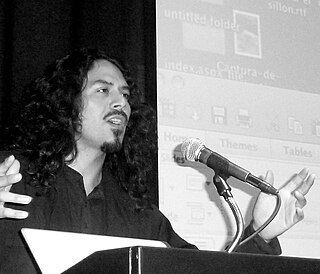Related Research Articles

The Whitney Biennial is a biennial exhibition of contemporary American organized by the Whitney Museum of American Art in New York City, United States. The event began as an annual exhibition in 1932; the first biennial was in 1973. It is considered the longest-running and most important survey of contemporary art in the United States. The Biennial helped bring artists like Georgia O'Keeffe, Jackson Pollock, and Jeff Koons, among others, to prominence.
Harrell Fletcher is an American social practice and relational aesthetics artist and professor, living in Portland, Oregon.
Sarah Sze is an American artist and professor of visual arts at Columbia University. She has exhibited internationally and her works are in the collections of several major museums. Sze's work explores the role of technology and information in contemporary life utilizing everyday materials. Drawing from Modernist traditions, Sze's work often represents objects caught in suspension.

Jens Hoffmann Mesén is a writer, editor, educator, and exhibition maker. His work has attempted to expand the definition and context of exhibition making. From 2003 to 2007 Hoffmann was director of exhibitions at the Institute of Contemporary Arts London. He is the former director of the CCA Wattis Institute for Contemporary Art from 2007 to 2016 and deputy director for exhibitions and programs at The Jewish Museum from 2012 to 2017, a role from which he was terminated following an investigation into sexual harassment allegations brought forth by staff members. Hoffmann has held several teaching positions including California College of the Arts, the Nuova Accademia di Belle Arti and Goldsmiths, University of London, as well as others.
Michelle Grabner is an artist, curator, and critic based in Wisconsin. She is the Crown Family Professor of Art at the School of the Art Institute of Chicago where she has taught since 1996. She has curated several important exhibitions, including the 2014 Whitney Biennial at the Whitney Museum of American Art along with Anthony Elms and Stuart Comer, and FRONT International, the 2016 Portland Biennial at the Oregon Contemporary, a triennial exhibition in Cleveland, Ohio in 2018. In 2014, Grabner was named one of the 100 most powerful women in art and in 2019, she was named a 2019 National Academy of Design's Academician, a lifetime honor. In 2021, Grabner was named a Guggenheim Fellow by The John Simon Guggenheim Memorial Foundation.

Anne Wilson is a Chicago-based visual artist. Wilson creates sculpture, drawings, Internet projects, photography, performance, and DVD stop motion animations employing table linens, bed sheets, human hair, lace, thread and wire. Her work extends the traditional processes of fiber art to other media. Wilson is a professor in the Department of Fiber and Material Studies at The School of the Art Institute of Chicago.
George Earl Ortman was an American painter, printmaker, constructionist and sculptor. His work has been referred to as Neo-Dada, pop art, minimalism and hard-edge painting. His constructions, built with a variety of materials and objects, deal with the exploration off visual language derived from geometry—geometry as symbol and sign.
Kate Clark is a New York-based sculptor, residing and working in Brooklyn. Her work synthesizes human faces with the bodies of animals. Clark's preferred medium is animal hide. Mary Logan Barmeyer says Clark's work is "meant to make you think twice about what it means to be human, and furthermore, what it means to be animal." Writer Monica Ramirez-Montagut says Clark's works "reclaim storytelling and vintage techniques as strategies to address contemporary discourses on welfare, the environment, and female struggles."
McArthur Binion is an American artist based in Chicago, Illinois. Binion was born in Macon, Mississippi. He holds a BFA from Wayne State University (1971) in Detroit, Michigan, and an MFA from Cranbrook Academy of Art in Bloomfield Hills, Michigan. He was a Professor of Art at Columbia College in Chicago from 1993 to 2015.

Jody Zellen is an American artist and educator. Her practice, consisting of digital art, painting, video art, and drawing, has been showcased by way of interactive installations, public art, and curated exhibitions. She is also known for her art criticism.
Tam Van Tran is a visual artist born in Vietnam who lives and works in Los Angeles, California. His primary materials for paintings and sculptures include clay and paper, and extend to chlorophyll, glass, algae, staples, crushed eggshells, Wite-out eraser liquid, beet juice, gelatin, and other diverse ingredients which lend texture and intricacy to his organically-molded abstractions.
Iris Eichenberg is a German post-war, contemporary artist, metalsmith, and educator. She is head of the Metalsmithing Department at the Cranbook Academy of Art.
Taravat Talepasand is an American contemporary artist, activist, and educator, of Iranian descent. She is known for her interdisciplinary painting practice including drawing, sculpture and installation. As an Iranian-American woman, Talepasand explores the cultural taboos that reflect on gender and political authority. Her approach to representation and figuration reflects the cross-pollination, or lack thereof, in our Western Society. Talepasand previously held the title of the chair of the painting department at San Francisco Art Institute (SFAI). She is an assistant professor in art practice at Portland State University.
Danielle Dean is a British-American visual artist. She works in drawing, installation, performance and video. She has exhibited in London and in the United States; her work was included in an exhibition at the Hammer Museum focusing on new or under-recognized artists working in Los Angeles.
Brenda Goodman is an artist and painter currently living and working in Pine Hill, New York. Her artistic practice includes paintings, works on paper, and sculptures.
Tony Labat is a Cuban-born American multimedia artist, installation artist, and professor. He has exhibited internationally, developing a body of work in performance, video, sculpture and installation. Labat's work has dealt with investigations of the body, popular culture, identity, urban relations, politics, and the media.

Daniel Turner is an American artist based in New York City. His media include sculpture, photography, video and drawing.
Matthew Angelo Harrison is an American artist living and working in Detroit, MI. His work investigates analog and digital technologies to explore ancestry, authenticity, and the relationship between African culture and African-American culture.
Carolina Caycedo is a multimedia artist based in Los Angeles.

William Cordova is a contemporary cultural practitioner and interdisciplinary artist currently residing between Lima, Peru; North Miami Beach, Florida; and New York.
References
- ↑ "Lisa John Rogers on Maya Stovall". www.artforum.com. Retrieved 2019-04-12.
- 1 2 "Liquor stores create frame for Detroit artist". Detroit News.
- ↑ "Artist Maya Stovall Talks Exploring Detroit and Other Cities Through Her Work". Vice. Retrieved 2019-04-11.
- ↑ "Dr. Maya Stovall". www.cpp.edu. Retrieved 2019-04-12.
- 1 2 "Maya Stovall: Under New Ownership". Fort Mason Center for Arts & Culture. Retrieved 2019-04-12.
- ↑ Pogrebin, Robin (17 November 2016). "Here Comes the Whitney Biennial, Reflecting the Tumult of the Times". The New York Times– via NYTimes.com.
- ↑ Liquor Store Theatre: Ethnography and Contemporary Art in Detroit - ProQuest (Thesis). ProQuest 2030525889.
- ↑ "Alumni Connections - No. 149 - January 2017". The University of Chicago Booth School of Business. Retrieved 2019-04-12.
- ↑ Howard University (2004-01-01). "The Bison: 2004". Howard University Yearbooks. 81.
- ↑ "Maya Stovall: MANIFESTO". whitney.org.
- ↑ Smith, Roberta (16 March 2017). "Why the Whitney's Humanist, Pro-Diversity Biennial Is a Revelation". The New York Times– via NYTimes.com.
- ↑ "Fictions Artists Announced". The Studio Museum in Harlem. 2017-09-02. Retrieved 2019-04-12.
- ↑ Cotter, Holland (2017-12-27). "From the Personal to the Political, 19 Artists to Watch Next Year". The New York Times. ISSN 0362-4331 . Retrieved 2019-04-12.
- ↑ Nkuleko, Nkosi (2018). "Mirror, Mirror: Nkosi Nkuleko after Maya Stovall" (PDF). Ekphrastic Poetry Reading.
- ↑ "Maya Stovall: Compulsion and Heart" . Retrieved 2019-04-12.
- ↑ Studio, Familiar. "Vivid Memories of a Blurred Past". Atlanta Contemporary. Retrieved 2019-04-12.
- ↑ "Graham Foundation > Grantees > Contemporary Art Museum St. Louis". www.grahamfoundation.org. Retrieved 2019-04-12.
- ↑ "Maya Stovall: Liquor Store Theatre Performance Films". Cranbrook Art Museum. 16 June 2017. Retrieved 2019-04-12.
- ↑ "Corktown gallery Reyes Finn is latest arts exhibitor working in Detroit". Detroit Free Press. Retrieved 2019-04-12.
- ↑ "2017 | Jessica Silverman Gallery". jessicasilvermangallery.com. Retrieved 2019-04-12.
- ↑ "HOMEMADE". Library Street Collective. Retrieved 2019-04-12.
- ↑ Art, Maryland Institute College of (2018-03-07). "On Public Display". Maryland Institute College of Art. Retrieved 2019-04-12.
- ↑ "MOCA's show Believe rewards our faith and patience | The Star". thestar.com. 22 September 2018. Retrieved 2019-04-12.
- ↑ "| PMP | FILM SCREENING | Performance in Public / Public in Performance". The Newbridge Project. Retrieved 2019-04-12.
- ↑ "Maya Stovall: A something = x". parrasch heijnen gallery. Retrieved 2021-09-23.
- ↑ "Maya Stovall - Pop Montreal". www.google.com. Retrieved 2019-04-12.
- ↑ "Shell and Glimpse". Pulitzer Arts Foundation. Retrieved 2019-04-12.
- ↑ "AT LARGE (Part 1 and 2) | REYES | FINN | Artsy". www.artsy.net. Retrieved 2019-04-12.
- ↑ "Maya Stovall: Under New Ownership | SFAI". www.sfai.edu. Retrieved 2019-04-12.
- ↑ "2021 AHAN: Studio Forum Acquisitions | Unframed". unframed.lacma.org. 9 August 2021. Retrieved 2021-09-23.
- ↑ "Maya Stovall". www.whitney.org.
- ↑ "Whitney Museum Acquired 417 Works Recently, Faith Ringgold, Derrick Adams, Toyin Ojih Odutola, and Julie Mehretu are Among the Artists Represented". 28 September 2018. Retrieved 2019-04-12.
- ↑ "November Exhibitions: 18 New Shows Feature African American Artists Nick Cave, Ellen Gallagher, Sam Gilliam, Mark Bradford, Nina Chanel Abney, Kehinde Wiley, and More" . Retrieved 2019-04-12.